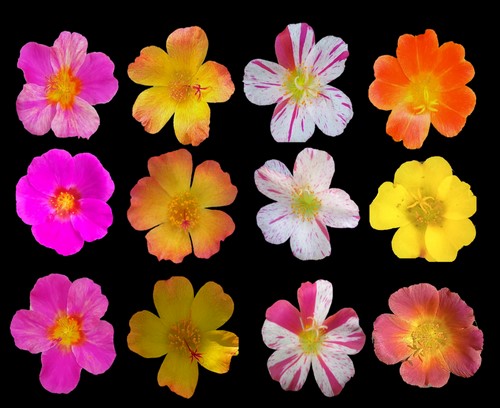Floral biology and agronomic evaluation of three hybrids of Portulaca umbraticola (Portulacaceae)
DOI:
https://doi.org/10.30972/bon.3326433Keywords:
Hybrids, Portulaca umbraticola, reproductive system, stigma, pollenAbstract
Portulaca umbraticola is an ornamental plant of the Portulacaceae family widely used in gardening. The objective of this study was to evaluate the pollen viability, stigmatic receptivity and agronomic behavior of three hybrids of Portulaca umbraticola obtained in 2021, Tekila Sunset, Coral Lipstick and Star Blush in comparison to commercial cultivars pink, yellow and orange from Vigrow Seeds®. Measurements were taken in five quantitative and five qualitative variables for the agronomic evaluation. Pollen viability and stigmatic receptivity were evaluated using 1% acetic carmine staining and with hydrogen peroxide, respectively. Significant differences were obtained in the quantitative variables (p≤0,05), with the commercial cultivars being the largest. In terms of pollen viability, the cultivars with the lowest and highest amount of viable pollen were Coral Lipstick and Tekila Sunset with 17,4% and 91.6%, respectively. There were significant differences (p≤0,05) in terms of cultivars, timing and cultivar × timing interaction for stigmatic receptivity, which was greater in the range of 11:00-3:00 p. m. for most cultivars. Agronomically adapted hybrids with novel coloring patterns were obtained for the ornamental market. In future breeding programs, it is recommended to take as male parents those with the highest pollen viability and carry out pollinations in the time range where the stigma is most receptive.
Downloads
References
BABA, N. M, BALOGUN, S. T., ODEY, F. C., DADA, K. E., IDRISU, M., UGIORO, O. & OYELEDUN, K. O. (2020). Evaluation of pollen viability and in vitro pollen germination in relation to different maturity stages of flowers in kola (Cola nítida). Global Scientific Journal 8: 516-525.
BAZZO, S. I., ESPEJO, J. R., PALOMINO, A. C., FLORES, P. F., CHANO, L. M., LÓPEZ, B. C. & MANSILLA, S. R. (2018). Estudios de biología floral, reproductiva y visitantes florales en el “loche” de Lambayeque (iCucúrbita moschata Duchesne). Ecología Aplicada 17: 205-191. http://dx.doi.org/10.21704/rea. vl7i2.1239
BAPTISTE, F. & JONG-YI, F. (2023). Study on pollen viability and stigma receptivity throughout the flowering period in the selected taxa of the Gesneriaceae family. Folia Florticulturae 35: 123-133
BAUM, D. A. & WHITLOCK, B. A. (1999). Plant development: Genetic clues to petal evolution. Current Biology 9: 525-527.
CARRODEGUAS-GONZALEZ, A. & ZÚÑIGA-OROZCO, A. (2023). Métodos utilizados para la selección de parentales en pre-mejoramiento genético de plantas. Cultivos Tropicales 43: el5.
CARRODEGUAS-GONZÁLEZ, A., ZÚÑIGA-OROZCO, A., & ORTIZ-CRÚZ, M. V. (2022). Instrumento de valoración del potencial ornamental de la flora silvestre: Aplicación en orquídeas cubanas. Avances en Investigación Agropecuaria 25: 41-56. https://doi.org/10.53897/RevAIA.21.25.15
DAFNI, A. & FIRMAGE, D. H. (2000). Viabilidad y longevidad del polen: implicaciones prácticas, ecológicas y evolutivas. Plant Systematics and Evolution, 222: 113-132. https://doi.org/10.1007/ BF00984098
DATTA, S. K. (2021). Breeding of ornamentáis: Success and technological status. TheNucleus 65: 107-128
DE FREITAS, L. M., DOS SANTOS PESSOA, A. M., DO REGÓ, E., DOS SANTOS PESSOA, R. M., NOGUEIRA LIMA, E., DA SILVA RIBEIRO, J. E. & CAMPOS DE MAGALHAES, C. H. (2022). Potencial ornamental de accesos de Portulaca umbraticola Kunth. VII Congresso brasileiro de recursos genéticos, Brasil. https://anais.infobibos.com.br/cbrg/7/e-poster.html
Dos SANTOS, J. W. (2010). Sistema reprodutivo de Portulaca grandiflora Hook. com vistas ao melhoramento vegetal. Tesis de Maestría, Universidad Estatal del suroeste de Bahía, Brasil. 135 pp.
GARCÍA, B., QUIROZ, S., YUSTIS, J. C., MARTÍNEZ, T. GARAY-ARROYO, A., SÁNCHEZ, M. & ALVAREZ- BUYLLA, E. (2020). La regulación genética de la floración. Mensaje Bioquímico 44: 20-30
GARCÍA, L., RIVERO, M. & DROPPELMANN, F. (2015). Descripción morfológica y viabilidad del polen de Nothofagus nervosa (Nothofagaceae). Bosque 36: 496-487. https://doi.org/10.4067/S0717-92002015000300015
GONNELLA, M., CHARFEDDINE, M., CONVERSA, G. & SANTAMARÍA, P. (2010). Purslane: a review of its potential for health and agricultural aspects. The European Journal of Plant Science and Biotechnology 4: 131-136.
IMN (2023). Clima del Valle Central de Costa Rica. Instituto Meteorológico Nacional, Costa Rica. https://www.imn.ac.cr/web/imn/mapa (Consulta 03/12/2023).
JYOTI, C., KUMAR, R., RAJASEKHARAN, P. E., NAIR, S. A. & BHARAIHI, T. U. (2023). Pollen germination and stigma receptivity in China áster (Callistephus chinensis Nees). International Journal of Pharmaceutical Science Inventionn 12: 01-03.
KIM, I. & CARR, G. (1990). Reproductive Biology and Uniform Culture of Portulaca in Hawaii. Pacific Science 44: 123-129.
KIM, I. (2013). Morphological Features of Pollen Grains in Portulaca. Applied Microscopy 43: 75-80. https:// doi.org/10.9729/AM.2013.43.2.75
LAGOS, T. C., CAEIANO, C. M., VALLEJO, F. A., MUÑOZ, J. E., CRIOLLO, H. & OLAYA, C. (2005). Caracterización palinológica y viabilidad polínica de Physalis peruviana L. y Physalis philadelphica Lam. Agronomía Colombiana 23: 61-55.
MCINNIS, S. M., EMERY, D. C., PORTER, R., DESIKAN, R., HANCOCK, J. T. & HISCOCK, S. J. (2006). The role of stigma peroxidases in flowering plants insights from further characterization of a stigma-specific peroxidases (SSP) from Senecio squalidus (Asteraceae). Journal of Experimental Botany 8: 1846-1835.
MEKAPOGU, M., SONG, H. Y., LIM, S. H. & JUNG, J. A. (2023). Genetic engineering and genome editing advances to enhance floral attributes in ornamental plants: an Update. Plants 12: 3983. https://doi.org/10.3390/plants12233983
MIYAJIMA, D. (2006) SeedProducing System in Portulaca oleraceae L. Asían joumal Journal of Plant Sciences 5: 226-232.
RODRÍGUEZ, C. (2014). Estudio comparativo de la propagación y el efecto de la radiación lumínica, en una variedad comercial y una población natural de Portulaca olerácea L. Tesis de Grado, Universidad de Sevilla, España. 60 pp. https://idus.us.es/ handle/11441/72586
SANDÍ, H., ZÚÑIGA, A. & CARRODEGUAS, A. (2022). Obtención de híbridos de Portulaca umbraticola a través de cruzamientos convencionales. Revista FAVE-Ciencias Agrarias 2: 85-98. https://doi. org/10.14409/fa. v21 i 1.11124
SOUZA, J. DA S., REGÓ, E. R. DO, FREITAS, N. DE S. S., PESSOA, A. M. DOS S., SILVA, P. D., & REGÓ, M. M. DO. (2023). Phenotypical characterization of Portulaca umbraticola: A non-conventional edible ornamental crop. Acta Scientiarum Agronomy 46: e62326. https://doi.oig/10.4025/actasciagron.v46il.62326
WICKRAMASINGHE, P, HARRISON, D. & JOHNSTON, M. (2009). Reproductive biology and intergeneric breeding compatibility of ornamental Portulaca and Calandrinia (Portulacaceae). Australian Joumal of Botany 57: 697-707. https://doi.org/10.1071/ BT09107
XIE, C., Hu, C., DENG, X., SHAO, W., GAO, Y., HUANG, W., & SONG, X. (2023). Relación entre el color de las flores y los factores físico-químicos celulares en Bletilla striata. Horticulturae 9: 426. https://doi. org/10.3 3 90/horticulturae9040426
ZHANG, J. H., ZENG, J. C., WANG, X. M., CHEN, S. F., ALBACHC, D. & Li, H. Q. (2020). A revised classification of leaf variegation types. Flora 272: 151703.

Downloads
Published
Versions
- 2024-08-28 (4)
- 2024-08-15 (3)
- 2024-07-12 (2)
- 2024-07-12 (1)
How to Cite
Issue
Section
License
Copyright (c) 2024 Bonplandia

This work is licensed under a Creative Commons Attribution 4.0 International License.
Declaration of Adhesion to Open Access
- All contents of Bonplandia journal are available online, open to all and for free, before they are printed.
Copyright Notice
- Bonplandia magazine allows authors to retain their copyright without restrictions.
- The journal is under a Creative Commons Attribution 4.0 International license.














.jpg)


